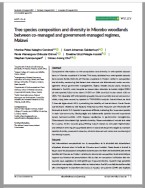Comparative information on the composition and diversity in tree species associations in Miombo woodland is limited. This study assessed how tree species associations across forest reserves of Miombo woodland in Malawi varied in composition and diversity concerning site factors and resource use disturbances under co-management versus government management. Eighty nested circular plots, randomly selected in ArcGIS, were sampled to record stem diameter at breast height (DBH) of tree species: 0.04 ha for stems 5–29.9 cm DBH and 0.16 ha for stems ≥30 cm DBH. The recorded 109 tree species grouped into communities and 14 sub-communities, using stem counts by species in TWINSPAN analysis. Sub-divisions to level 5 showed eigenvalues ≥0.3, symbolising the stability of sub-divisions. North/South sub-divisions related to site factors; historical/current resource use influenced differences at levels 3–5. Species importance differed, indicating few important species in each sub-community. Brachystegia and Julbernardia species showed importance across sub-communities while Uapaca sansibarica in government management. Disturbances stimulated high species diversity. Recommendations include the need for a policy review towards group-felling mature stands to stimulate regeneration and selective thinning of suppressed stems in stand development stages to maintain species diversity, productive recovery, diverse resource use value, and monitoring of harvesting impacts.

